#quaithe of the shadow
Explore tagged Tumblr posts
Text
Posting the second piece I did for the Unburnt Daenerys collab cause yeah I did two.

It's Daenerys vision of Quaithe and I decided to represent the whole menagerie she talks about in her little prophecy : "Soon comes the pale mare, and after her the others. Kraken and dark flame, lion and griffin, the sun's son and the mummer's dragon."
#daenerys targaryen#quaithe of the shadow#a dance with dragons#asoiaf art#valyrianscrolls#house targaryen#feat : tyrion victarion jon connington young griff quentyn martell#didnt draw moqorro's symbol i didnt know how to put dark flames here#i really wanted to experiment a bit with this piece
33 notes
·
View notes
Text




Top: ‘Shiera = Quaithe’
Bottom: ‘Bloodraven the Last Greenseer’
Favorite set to date!
Custom asoiaf-themed lockets will restock on Sunday, March 16th at 10am PST.
#asoiaf#a song of ice and fire#fire and blood#shiera seastar#bloodraven#brynden rivers#quaithe of the shadow
5 notes
·
View notes
Text
Magic User Slapfight - Round 2



Bran: art by elaena, AWOIAF Page

Quaithe: art by cappucosmic, AWOIAF Page
BRACKET LINK
3 notes
·
View notes
Text
smth smth quaithe's touch making dany's skin tingle signifies some sort of relationship between flame and shadow.
#;; THE FACT THAT THIS TAKES PLACE WHILE THEY'RE WATCHING A FIRE MAGE SHOW#;; THERE'S SOMETHING *THERE* BECAUSE EVEN MEL MENTIONS HOW FLAMES CAN RAISE SHADOWS AS MUCH AS THEY CAN SHRINK THEM#;; WHERE THERE ARE FLAMES THERE ARE SHADOWS !!!#;; AND WHERE DANY IS POST DRAGONS . . . QUAITHE ALWAYS MANAGES TO FIND HER AND PUT HER BACK ON THE PATH#;; but *also* HER WRIST COULD HAVE JUST TINGLED BECAUSE QUAITHE WAS TRYING TO *SHOW* DANY HOW HER BIRTHING OF THE DRAGONS HAS#;; BOOSTED MAGIC IN THEIR WORLD!#;; BUT ALSO QUAITHE'S WHOLE THING ABOUT WANTING TO SHOW DANY THE WAY . . . IS SO INTERESTING TO ME SINCE SHE IS ASSOCIATED#;; WITH SHADOWS !!!#♕░░ daughter of death ; slayer of lies ; bride of fire ( GENERAL )
3 notes
·
View notes
Text
TO SANSA/JON FANDOM!
Hey everyone! I’m not sure how many of you remember this user, but lostlittlesatellites or batterydeaddotdot was a well-known Jonsa meta-writer in our fandom. Sadly, they deactivated, and as far as I know, we don’t really know why. A big chunk of their amazing work seems to have been lost, which was so sad for so many of us.
But here’s the good news: I recently discovered that some of their metas were saved on the "Way Back Machine" site! So, I put together a list of some of their pieces to share with all of you. My aim is to help preserve their contributions, spread the love within our fandom, and celebrate the incredible mind that has helped to shaped our fandom.
Quick disclaimer: I haven’t read every single meta, so I don’t necessarily agree with everything that’s written. My main goal is just to share this with you all. And I skiped GOT-related metas for this list. Enjoy diving into lostlittlesatellites/batterydeaddotdot’s work!
Some of their writings is already saved through some of those accounts: @/jonsameta & @/bookjonsa & @/esther-dot. Y’all can check! Here are the others:

BOOKS:
Sansa Stark: The Princess in the Tower
RLJ & Jonsa Payoff
Dragons, Snow and Armchairs
Can there be ONE ideal ruler?
Trojan War Literature influence on GRRM
The Red Comet: A Closer Look
Grey Dawn: Hour of the Wolf + Nightingale
To go forward you must look back: Dany’s tragic fall
Jon Snow as an Anti Hero
Val: A Subversion of BATB in Jon’s arc? + “something off about Val”
The Resurrection Problem
The Cost of Weaponizing Dragons For a Cause: Doran + Jon
There is Power in Living Wood: Bran’s role in the War
Valar Morghulis: Could Arya kill Dany?: Part 1 & Part 2
Stark Girls’ connections: To go forward you must go back
Fathers and Daughters
Sansa Stark: A Winter Rose?
Sansa Stark: A Girl in Glass
Sansa’s Fairytale and Myth allusions
The Blindspot of FPTP thread: Oversexualisation and overlooking age
Ask: Does “begging for a stranger’s kiss” foreshadow Sansa/Hound?
Deconstruction of BATB figures: He’s even uglier than the Hound
The Unkiss: The War Spilling Inside
Sansa’s repression of Jeyne
Alysanne: Paralleling Sansa + Contrasting Dany foreshadowing
A Song to Dodge A Kiss With a Blade (Part 1): Sansa/Hound and Jon/Ygritte ACOK comparisons
The Innocuous Nature of Jon/Sansa Foreshadowing
Snow: Lover’s Kisses
A Son by Marriage
1. Like a Lover; 2. Like a Kiss; 3. Kissed by Fire; 4. Burning Light and Dark Woods; 5. Intruders in Winterfell; 6. The Heart of Winterfell; 7. Fire: Hearth vs. Weapons
Dance of Dragons + Pact of Ice and Fire
Jonquils and Blue Roses
Horses and Flowers
Some Willowy Creature Who Sits Up in a Tower
A Union of the Old Gods and the New: Importance of understanding the Seven
Ask: Thoughts on Bridge4’s Video “There must always be a Stark in Winterfell”
Theories:
Bran as the Valonqar
History is a Wheel: Jon’s Rebellion
Jon’s Resurrection Repercussions
Dead Man with the Head of a Wolf: A Re-look
The Heart Tree of Winterfell: Tolkien influence
Complicating the Fantasy Battle: War Factions in the War for Dawn
Trail of Scrolls
Lady and the Ghost: Part 1; Part 2; Part 3
Shadowbinders, Death and Sacrifice
Sansa, the Vale and Mountain Clans: Part 1; Part 2; Part 3; Part 4
Seasons of My Love
Jon’s Survival: Beginning of Subverting Westerosi Classism
Child of Flame and Shadow: Not a living child but a shadow child?
Shadowbinders, Death and Sacrifice: Dany with Mirri and Melisandre
A Potential Wildcard Advisor: Bronze Yohn Royce and the Importance of the Vale
Why Ghost is unlikely to like Dany: Melisandre and Val in ADWD
Others:
Jonsa: Tolkien influences
Jonsa: A Good Endgame
Jonsa is happening because it's how GRRM's mind works
Jonsa’s Hints: On how antis ignore Jonsa foreshadowing
POV’S: Heros or not
House of the Undying and Quaithe for Dany & Mythology
Dany criticism
Other links: about asoiaf; asoiaf metas; asoiaf theories + part 2

Anyone who has some of their writing saved can feel free to share! I would be thankful.
309 notes
·
View notes
Text
Comparative Mythologies of the Long Night: Part Two – Azor Ahai and The Red Sword
In part one, we looked at the origin story of the Long Night, and the ways in which it is reflected in the main series. Now, we shall move on to discuss the heroes who seemingly saved the world.
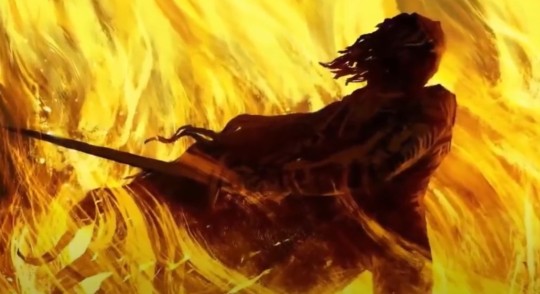
The most notable of these heroes, with whom you are likely aware, is the one most commonly known as Azor Ahai; emerging from Asshai, this is the hand that wields the flaming sword Lightbringer. They are also known as Hyrkoon the Hero, Yin Tar, Neferion, and Eldric Shadowchaser.
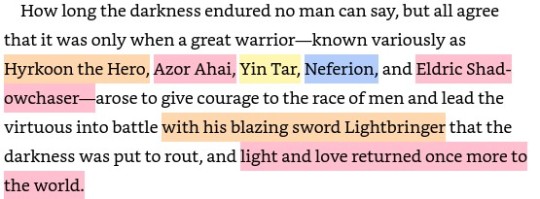
As a brief aside, it is interesting to note that all of these names can be related to specific places in Essos; the Patrimony of Hyrkoon is an ancient nation, Yin is a city in Yi Ti that has often been its capital, ‘Nefer’ is the last city in the distant kingdom of N’ghai, ‘the Shadow’, or the ‘Shadow Lands’ are a region in the furthest east, with AssHAI in the southwest, serving as something of a gateway to them – and it is the Shadow, as we will later learn, from whence the dragons may have first originated; tamed by an ancient, unnamed people.
Whether this solid anchoring of these heroic aliases in various places means anything more than a suggestion that the hero – or heroes – may have come from there, or were perhaps claimed by those peoples, I will leave you to ponder. For now, we shall turn to Azor Ahai’s legend.
Of Azor Ahai (AA), we have the most available information of all of the legends we shall discuss. He is also the only one explicitly prophesied to return again, and the manner in which AA shall return and be heralded is very clearly laid out for us from multiple sources.

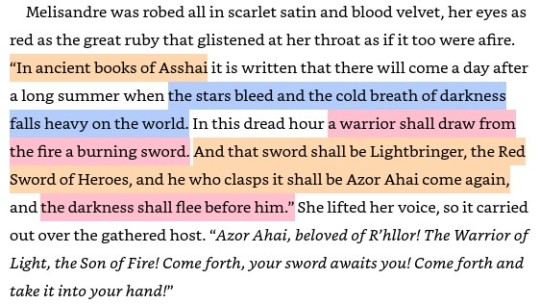

AA is described as a leader, wielding a burning sword that radiates heat and light. He gave ‘courage to […] men and [led] the virtuous into battle’, returning ‘light and love’ to the world. So we should account for these aspects, as well as the finer points of the prophecy.
Much has been said about who AA reborn might be, with many candidates proposed. I will not be spilling that ink here; it’s Daenerys. Born on Dragonstone, a smoking isle in the great salt sea, she arose when darkness gathered and, beneath a bleeding star, awoke dragons from stone.



I would also point out that even Jon Snow, upon hearing of the Prophecy in the context of Mel’s candidate Stannis, zeroes on the importance of Stannis not being born on Dragonstone. One can almost hear the author himself tapping his fingers impatiently, no?
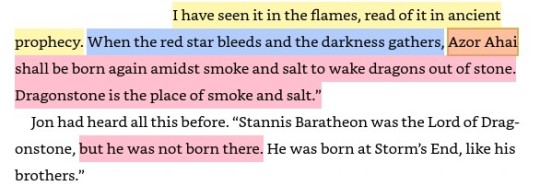
If you favour another candidate, a more abstract interpretation of the prophecy, feel free to do your own research and present it elsewhere; I am interested primarily in exploring the myths, not arguing. However, I do hope you will let me expand on my case and consider it fairly.
Dany becomes a leader, bringing hope and courage to mankind and returning light and love to those lost in the darkness. Moreover, she inspires them to fight for themselves, for their lives and loves; leading them into battle, but not doing their fighting for them.
I would also briefly highlight this echo of command from Quaithe, in light of one of AA’s names being ‘Shadowchaser’ – and that Quaithe wishes Dany to go to Asshai, from whence the myths of AA were born and the prophecy was written.

Going back here may mean in a temporal sense, revisiting the origins of AA and learning who he was, what he did, and most notably for Daenerys, why it was needed. She is, as present, unaware of the encroaching darkness that threatens the world, on any level except subconsciously through her dreams. A revelation is needed.
To add to this, we have the ‘Prince that was Promised’ title; these are used interchangeably with AA by Mel and by Maester Aemon and seem to often refer to the same person; in light of GRRM’s addition of Aegon’s dream to the canon, my interpretation is that they do refer to the same person, but by accident. Though we do not yet have it in GRRM’s words, Aegon saw the return of the Long Night and a Targaryen fighting against it. This is tPtwP, Aegon’s name for this leader who happens to also be the one who woke the dragons from stone to fight the cold.
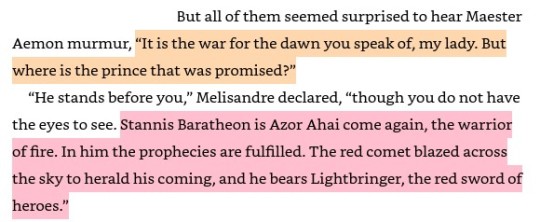
And it is Aegon’s dream that dream-driven Targaryens have stumbled across in their scrolls – what Rhaegar to become a warrior and thence to confer the promise he initially saw in himself upon his newborn son. The Red Priests who herald Dany speak only of AA; Mel may have discovered tPtwP on Dragonstone itself. All other sources for the Promised Prince title seem to be either Targaryen or Targaryen adjacent – such as Barristan, who himself speaks of Jenny of Oldstones’ witch friend, presumably close to certain Targaryens.

But what of Lightbringer? Daenerys is not trained in arms, so how can she wield a sword? Recall that AA reborn is marked by waking dragons from stone and wielding Lightbringer. There is no separate mention of forging/reforging a sword. Perhaps there is more to the tale than that?
So let us examine Lightbringer and its forging; AA makes three attempts to forge the blade, quenching it in water, lion’s blood and, in his successful forging, the living heart of his wife, Nissa Nissa. The blade is described, by the Jade Compendium, as making its own fiery heat.




The blade never being cold, but being warm as Nissa Nissa was warm, is very alike to the description of dragons being ‘fire made flesh’; and the description of Lightbringer in action resembles nothing so much as the affect of Drogon’s flames. Lightbringer, Red Sword of Heroes, is not a blade; it is the dragons awoken from stone. But what of the three forgings? The exact arrangement of the forgings is sometimes debated, but the one I favour is this arrangement: the first forging in ‘water’.
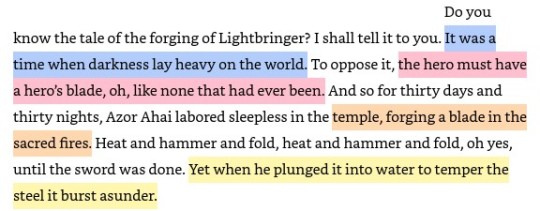
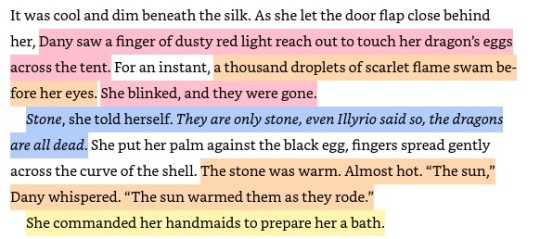
The second in the ‘heart of a lion’; note that this moment is so important it appears again in the dreams that guide Dany’s steps to her eventual success.


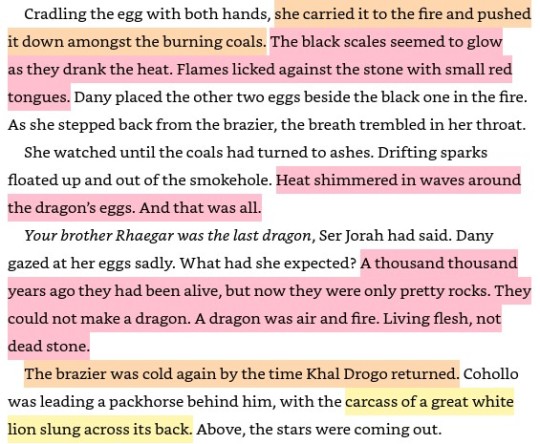

And the third, successful forging – in the ‘sacred flames’ of a funeral pyre, fed by the blood of heart’s beloved. Note the proximity of the water/lion/heart imagery on each occasion, and that the conversations following the first scenes are about dragons, and then about war.
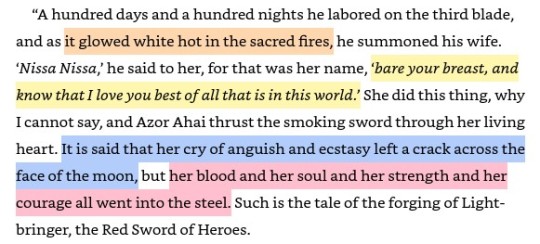

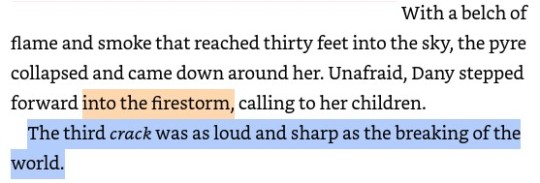
In the chapter prior to the pyre, Dany has dreams haunted by a pursuing cold, and by ghosts urging her on, with very familiar gemstone eyes; this links Dany and the dragons explicitly to the Great Empire of the Dawn and thus to the Long Night that followed the Blood Betrayal.

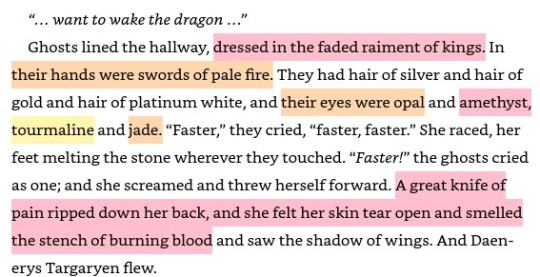
These dreams also link the dragons to sacrifice, just as Lightbringer is linked to Nissa Nissa’s sacrifice. Dany’s dreams show us the lives lost in her journey to that point (though Drogo is not yet entirely lost to her); those she has lost will lend their names to the dragons.
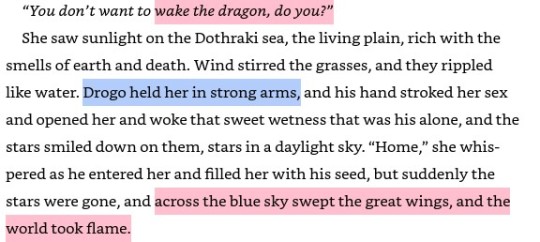
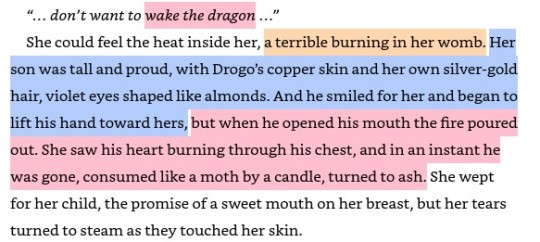
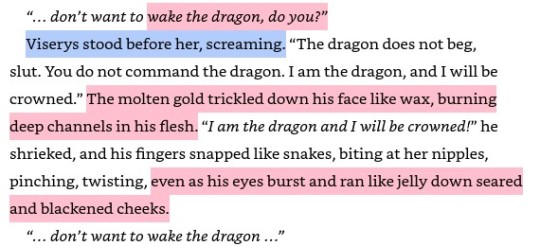
Blood sacrifice is a deeply potent power, both within ASOIAF and without. Many characters tell us of the potency of shed blood; of kin, king, and of holy men. Within many cultures in our own world, blood sacrifice was a holy act, to ward off catastrophe, as payment – and penance.
In Aztec mythology, for instance, it is now generally understood that blood sacrifice, both of slain captives but also one’s own blood on a daily basis, was both a fuel offered up to the gods for their daily labours, and as repayment for the debt owed by the living to the gods for their sacrifices made when creating the fifth sun, and so all human life. The dreams emphasise Dany’s own shed blood from the beginning; in her bloody footsteps, the burning in her womb, and the burning blood from her torn open back, which ultimately grants her wings.
When the time comes, she offers up her own blood by walking unafraid into the sacred flames of the funeral pyre, to bleed with her fallen beloved. Dany alone, among all Targaryens who have attempted to bring back dragons, took the last and most important step of self-sacrifice.
But if we understand blood sacrificed to be offered up, not just for power but for payment of debt, what debt is Dany paying here? Moreover, have we strayed from AA in this talk of blood magic and penance? I would argue not; for just as Dany’s Lightbringer is living dragons, so too do I believe that AA’s red sword was no literal blade, but dragons also.
I would here posit that Azor Ahai, in the coldest, darkest night, sought to bind fire made flesh to humankind. I propose that he tried and failed twice, before binding dragons to the fate of men.
I implore you to consider that Nissa Nissa was a dragon.
This concludes Part Two. Part Three shall answer the question, ‘what in the world did she mean by that last comment?’, by examining sacrifice, necessity, and the long, sad history of House Targaryen’s ritual offerings of innocence as payment.
#ASOIAF#ASOIAF theory#a song of ice and fire#ASOIAF magic#The Long Night#The Blood Betrayal#WOIAF#ASOIAF Lore#ASOIAF Mythology#Branwyn's Twitter Threads#Azor Ahai#Daenerys Targaryen#Daenerys Stormborn#Daenerys is azor ahai#Lightbringer#ASOIAF Prophecies#dragons#ASOIAF dragons#Lightbringer is dragons#Nissa Nissa was a dragon#Comparative Mythologies of the Long Night Part 2/?#Comparative Mythologies of the Long Night
81 notes
·
View notes
Text
Jorah and Daenerys will be judging the outfits😂

@salzrand - Still loving that tiger cloak *chef's kiss* I seriously need to go to Qarth's Fashion Week XD New chapter is up! Xo
#ashara dayne#quaithe#jorleesi#game of thrones#fanfic#fanfiction myarts#myart#shadow & eventide#you go ashara-girl😍😍😍#i want tiger cloak#😂
16 notes
·
View notes
Text
The Dragon has Three Heads or, How I Learned to Stop Worrying and Believe That Young Griff is the Real Deal
Before going any further, I want to warn anyone reading this analysis that it will contain spoilers for A Dance With Dragons, so proceed at your own risk.
This essay came about from an 'epiphany' I had while reading ADWD on break at work, specifically chapter Daenerys VII. In this chapter, Quentyn Martell and his companions present themselves to Daenerys and offer her a marriage alliance with Dorne. This being the day of her wedding to Hizdahr zo Loraq, Dany refuses and makes note mentally of Quaithe's earlier warning about not trusting "the Sun's Son." The identification seems simple enough, with House Martell's sigil featuring the sun and Quentyn being the son of Doran Martell, Prince of Dorne, but there are serious problems with this conclusion.
The issue with labeling Quentyn Martell the Sun's Son stems from how Dany reaches this conclusion; for starters, this is the original quote given by Quaithe in Daenerys II:
"No. Hear me, Daenerys Targaryen. The glass candles are burning. Soon comes the pale mare, and after her the others. Kraken and dark flame, lion and griffin, the sun's son and the mummer's dragon. Trust none of them. Remember the Undying. Beware the perfumed seneschal."
And this is how Dany identifies Quentyn as the Sun's Son in Daenerys VII and VIII:
Something tickled at her memory. "Ser Barristan, what are the arms of House Martell?"
"A sun in splendor, transfixed by a spear."
The sun's son. A shiver went through her. "Shadows and whispers." What else had Quaithe said? The pale mare and the sun's son. There was a lion in it too, and a dragon. Or am I the dragon? "Beware the perfumed seneschal." That she remembered. "Dreams and prophecies. Why must they always be in riddles? I hate this. Oh, leave me, ser. Tomorrow is my wedding day."
...
The pale mare. Daenerys sighed. Quaithe warned me of the pale mare's coming. She told me of the Dornish prince as well, the sun's son. She told me much and more, but all in riddles.
George has talked about the fickle nature of prophecy in the books and publicly, citing the Duke of Somerset's death at the Battle of St. Albans in Shakespeare's Henry VI as an example of why the literal or easiest interpretations are not always the most reliable. While Dany's conclusion that Quentyn is the 'Sun's Son' seems straightforward, she bases it solely on Barristan's description of the Martell arms. Her reasoning is mainly to justify marrying Hizdahr by dismissing the Martell offer, as Dany herself barely remembers Quaithe's warning and bemoans her 'riddles'.
Assuming that the 'Pale Mare' refers to the 'bloody flux' that the Astapori refugees bring to Meereen, and that the Kraken, dark flame, lion, griffon and mummer's dragon refer to Victarion Greyjoy, Moqorro, Tyrion, Connington and Young Griff respectively, the sequence of Quaithe's warning makes no sense with Quentyn as the 'Sun's Son.' At the end of ADWD, Tyrion is outside the walls of Meereen while Victarion and Moqorro are en route with the Iron Fleet, and Connington and Young Griff are in Westeros. If Dany's return to Meereen from the Dothraki Sea is followed by her journeying westwards, then this sequence makes sense. Victarion will likely destroy the Slaver's fleets and is seeking Dany's hand in marriage, while Moqorro is with him for the purpose of acknowledging her as Azor Ahai and encouraging her to free the slaves of Volantis. Given Tyrion's association with Varys, Illyrio, Jorah and now 'Brown Ben Plumm,' and his family's role in Robert's rebellion, it makes sense that he would not immediately seek out Daenerys on her return to Meereen. Connington and Young Griff await her in Westeros, but Quentyn as the 'Sun's Son' precedes all of them, breaking Quaithe's otherwise sensible sequence. If Quentyn were the 'Sun's Son' he could just as easily have been paired with the Kraken, since both are sent by the heads of their houses to offer her an alliance, while Tyrion and Moqorro travel together on the Selaesori Qhoran (the 'Perfumed Seneschal') and Connington and Griff are in league with Varys.
The far greater issue with Dany's interpretation is that we have access to Quentyn's POV, and there is nothing to suggest that he seeks to betray Daenerys. His purpose was to approach Dany with a marriage alliance, to assist her in reclaiming her crown; his party was even sent by Tatters to scope out the situation in Meereen for a possible double-crossing of the Yunkai'i, specifically to aid Dany. The only thing close to untoward that he does is attempt to claim one of her Dragons, and this was a desperation move driven by his insecurities and his fear of returning to his father empty handed, which would mean that his fallen companions died for nothing:
"What name do you think they will give me, should I return to Dorne without Daenerys?" Prince Quentyn asked. "Quentyn the Cautious? Quentyn the Craven? Quentyn the Quail?" (The Discarded Knight, ADWD)
Volantis, Quentyn thought. Then Lys, then home. Back the way I came, empty-handed. Three brave men dead, for what?
...
His father would speak no word of rebuke, Quentyn knew, but the disappointment would be there in his eyes. His sister would be scornful, the Sand Snakes would mock him with smiles sharp as swords, and Lord Yronwood, his second father, who had sent his own son along to keep him safe … (The Spurned Suitor, ADWD)
Disqualifying Quentyn as the Sun's Son leaves us with only three options, of which only one really works. Trystane is the only other son of House Martell aside from Quentyn via Prince Doran, and given his limited roll in the story thus far I think it's safe to cross him off the list. Doran could theoretically work as the 'Sun's son,' as his mother was Princess of Dorne before him; given that Quaithe describes the figures as going to Dany, Doran's limited mobility and poor health would disqualify him. This leaves us with only one 'son of a sun,' that being 'Young Griff,' aka Aegon VI Targaryen, the son of Rhaegar Targaryen and Elia Martell, Princess of Dorne.
This association of Aegon with the Martells via his mother fits with the copious amounts of imagery linking him to the Rhoynar and to 'Egg' aka Aegon V of "Dunk and Egg" fame, specifically that character's travels in Dorne. Tyrion finds him living on a pole boat in the Rhoyne River, home of the ancient Rhoynar culture that Dorne descends from. The Shy Maid is operated by Yandry and Ysilla, so-called 'orphans of the Greenblood' which are another allusion to Dunk and Egg's travels on the Greenblood River in Dorne:
A poleboat had taken them down the Greenblood to the Planky Town, where they took passage for Oldtown on the galleas White Lady.
...
When they’d been poling down the Greenblood, the orphan girls had made a game of rubbing Egg’s shaven head for luck. (The Sworn Sword)
In Tyrion IV of ADWD, a massive horned turtle appears in the river by the Shy Maid, an obvious reference to the Rhoynish 'Old Man of the River,':
It was another turtle, a horned turtle of enormous size, its dark green shell mottled with brown and overgrown with water moss and crusty black river molluscs. It raised its head and bellowed, a deep-throated thrumming roar louder than any warhorn that Tyrion had ever heard. “We are blessed,” Ysilla was crying loudly, as tears streamed down her face. “We are blessed, we are blessed.”
Duck was hooting, and Young Griff too. Haldon came out on deck to learn the cause of the commotion . . . but too late. The giant turtle had vanished below the water once again. “What was the cause of all that noise?” the Halfmaester asked.
“A turtle,” said Tyrion. “A turtle bigger than this boat.”
“It was him,” cried Yandry. “The Old Man of the River.”
And why not? Tyrion grinned. Gods and wonders always appear, to attend the birth of kings.
When Tyrion and Haldon visit the Painted Turtle inn to find information about Daenerys' whereabouts, we have an interesting description of the inn from Tyrion:
The ridged shell of some immense turtle hung above its door, painted in garish colors. Inside a hundred dim red candles burned like distant stars. (Tyrion VI, ADWD)
We once more have Rhoynish symbolism in the turtle, while the 'garish colors' are reminiscent of Young Griff's hair, which is dyed blue in the Tyroshi fashion. Tyrion's description of inside the 'Painted Turtle' is one of dim red candles burning like stars, which can be seen as an oblique reference to the red rubies on Rhaegar's black breastplate, thereby associating the red of Targaryen heraldry with the cultural symbols of the Rhoynar.
The 'Dunk and Egg' imagery goes further, with both Egg and Aegon wearing distinctive straw sun hats, and being accompanied by their Hedge Knights from the Stormlands, both of whom have titles derived from their own simplistic personalities (Duncan the Tall, Rolly Duckfield). Moreover, Egg's journeying to Dorne ends up giving him refuge from the Spring Sickness that ravages Westeros, while Aegon's time in Essos serves as a refuge from Robert's spies and the chaos of the War of the Five Kings. While these similarities might be viewed as a doomed attempt by Varys to recreate Egg through Aegon, I think the purpose of these parallels is to establish both princes as following similar trajectories: both are sons of a Targaryen prince (Maekar, Rhaegar) and a Dornish noblewoman (Dyana Dayne, Elia Martell); become King of the Seven Kingdoms through unexpected circumstances: and if George plans to end ADOS with a mini-Dance of the Dragons, I would expect Aegon VI to meet a fiery end like Egg did.
If Young Griff is actually Aegon VI Targaryen as well as the 'Sun's Son,' this leaves the 'mummer's dragon' without any clear identity. Part of this is due to the conviction that Dany's identification of the cloth dragon from the undying visions with a 'mummer's dragon' or puppet dragon must be correct. In truth, there are countless cases from ADWD alone that show us that a mummer's object is not necessarily a puppet, but more broadly means something which is not as it appears:
I know one stands before me now, weeping mummer's tears. The realization made her sad. (Daenerys III, ADWD)
"Not here," warned Gerris, with a mummer's empty smile. "We'll speak of this tonight, when we make camp." (The Windblown, ADWD)
"My lord, I bear you no ill will. The rancor I showed you in the Merman's Court was a mummer's farce put on to please our friends of Frey."
...
I drink with Jared, jape with Symond, promise Rhaegar the hand of my own beloved granddaughter … but never think that means I have forgotten. The north remembers, Lord Davos. The north remembers, and the mummer's farce is almost done. My son is home." (Davos IV, ADWD)
His reign as prince of Winterfell had been a brief one. He had played his part in the mummer's show, giving the feigned Arya to be wed, and now he was of no further use to Roose Bolton. (The Turncloak, ADWD)
Fat Wyman Manderly, Whoresbane Umber, the men of House Hornwood and House Tallhart, the Lockes and Flints and Ryswells, all of them were northmen, sworn to House Stark for generations beyond count. It was the girl who held them here, Lord Eddard's blood, but the girl was just a mummer's ploy, a lamb in a direwolf's skin. So why not send the northmen forth to battle Stannis before the farce unraveled? (A Ghost in Winterfell, ADWD)
Mummer's tears and smiles are obviously false emotions, being affectations put on to hide what someone truly feels. Wyman Manderly is engaged in a mummer's farce wherein he pretends to be loyal to King Tommen and Roose Bolton, but in truth is scheming to restore the Starks to Winterfell and assist Stannis against the Boltons. Roose Bolton, Petyr Baelish and the Crown have in turn engaged in their own mummer's farce by sending Jeyne Poole north to wed Ramsay Snow in the guise of Arya Stark, "a lamb in direwolf's skin." If the 'mummer's dragon' is in fact a dragon that has been made to appear as something else, then Jon Snow more than fits this bill. By birth he should be a Targaryen, having been fathered by Rhaegar Targaryen upon Lyanna Stark; instead, his fortuitous Stark features inherited from his mother, and Ned's claiming Jon as his bastard and raising him amongst his children at Winterfell, has allowed Jon to hide in plain sight from those who would kill him for being Rhaegar's son.
The significance of Dany, Jon and Aegon being the three heads of the dragon is due to their mirroring a less conspicuous triad in George's World: elemental magic and it's connections to the Long Night. We are aware of three forms of elemental magic in the story, being pyromancy, cryomancy and hydromancy. Pyromancy is the most obvious, being the control and use of fire as we see with followers of Rhllor, and also tied to dragons. Cryomancy or ice magic appears in the powers of the Others and in the Wall separating the Seven Kingdoms from the lands beyond. Finally we have hydromancy or water magic, which was used by the Rhoynar against the Valyrian Freedhold and by Nymeria's Rhoynar settlers to support their communities within the deserts of Dorne. Company of the Cat has an excellent video discussing these three 'schools' of magic, but to summarize what she's said: Blue, Red and Green are the colours commonly associated with Ice, Fire and Water/the Sea in ASOIAF; in addition to being featured on the arms of ancient houses such as Massey and Strong, these elements are in turn associated with three magical items in the books. The first, The Horn of Joramun, can raise and lower The Wall (Ice); Dragonbinder, a horn that was likely used alongside similar horns to control the volcanoes of the fourteen flames in Valyria (Fire); and the 'Kraken summoning horn' which is most likely the Hammer of the Waters, since the Hammer raised the seas to swamp the 'Arm of Dorne,' which would have filled the seas fill with corpses of the dead and 'summoned' krakens, which would have fed on the bodies of the drowned.
The Valyrian, Northern and Rhoynish heritage of Dany, Jon and Aegon ties them to these three forms of magic respectively, and by extension to the Long Night. We are given three accounts of the Long Night between ASOIAF and TWOIAF, which I dub the 'western,' 'far eastern' and 'near eastern' versions. The 'western' account concerns the First Men, the Night's Watch, the Last Hero and the Others; the 'far eastern' account covers the 'Jade Compendium' and the Yi Tish account of the Blood Betrayal; and the 'near eastern' or Rhoynar account in which the children of Mother Rhoyne sang a song to return light to the world. Aegon is tied to the Rhoynish account through his mother's heritage, with references to the Rhoynish account in the 'Old Man of the River' appearing in ADWD and Dany's vision of Rhaegar talking about Aegon's 'Song' (that of Ice and Fire):
The Rhoynar tell of a darkness that made the Rhoyne of Essos dwindle and disappear, her waters frozen as far south as the joining of the Selhoru, until a hero convinced the many children of Mother Rhoyne, such as the Crab King and the Old man of the River, to put aside their bickering and join in a secret song that brought back the day. (TWOIAF: Ancient History: The Long Night)
...
“Will you make a song for him?” the woman asked.
“He has a song,” the man replied. “He is the prince that was promised, and his is the song of ice and fire.” (Daenerys IV, ACOK)
Jon's connection to the Northern account is obvious given his Stark lineage and service in the Night's Watch, as well as his dreams in ADWD:
Burning shafts hissed upward, trailing tongues of fire. Scarecrow brothers tumbled down, black cloaks ablaze. "Snow," an eagle cried, as foemen scuttled up the ice like spiders. Jon was armored in black ice, but his blade burned red in his fist. As the dead men reached the top of the Wall he sent them down to die again. He slew a greybeard and a beardless boy, a giant, a gaunt man with filed teeth, a girl with thick red hair. Too late he recognized Ygritte. She was gone as quick as she'd appeared.
The world dissolved into a red mist. Jon stabbed and slashed and cut. He hacked down Donal Noye and gutted Deaf Dick Follard. Qhorin Halfhand stumbled to his knees, trying in vain to staunch the flow of blood from his neck. "I am the Lord of Winterfell," Jon screamed. It was Robb before him now, his hair wet with melting snow. Longclaw took his head off. Then a gnarled hand seized Jon roughly by the shoulder. He whirled … (Jon XII, ADWD)
Finally, Dany is directly referred to as Azor Ahai in the books while her visions from Daenerys IX of AGOT connect her bloodline to the Great Empire of the Dawn. The eye colours of the figures she sees match the titles of four of the eight emperors of the GEOTD, Opal, Jade, Tourmaline and Amethyst, with the Bloodstone Emperor killing his sister the Amethyst Empress and causing the Long Night. Azor Ahai and the Bloodstone Emperor are themselves connected, and I recommend David Lightbringer's Nightbringer series and "Azor Ahai the Bad Guy" video for a concise explanation. It's worth noting that David is well within the Faegon Blackfyre camp, but I think his theories here more than fit my own conclusions also.
Aegon being one of the three heads also fits in with the symbolic relationship between water, fire and ice and the green, red and blue colour scheme. As Company of the Cat points out in her video about the magic horns (timestamp 26:52), green is a secondary colour made from a 'cool' and a 'warm' colour, placing it in the middle of the spectrum while red and blue are polar opposites. Similarly, fire can melt ice back into water and water in turn quenches fire, situating Aegon at a middle ground between Jon's ice and Dany's fire. Whereas Jon's only aspect of himself that ties him to House Targaryen is his father and otherwise he is firmly associated with his mother's house, Dany is tied symbolically to her Targaryen identity in the books, being a product of Targaryen incest, the first to hatch dragons in over a century, and her ties to fire through her 'rebirth' on Mirri's pyre under the Red Comet. While Aegon's physical appearance and his father tie him clearly to House Targaryen like Dany, the support of his mother's family alongside his Rhoynar lineage and symbolism place him in a similar situation to Jon, besides their being half-brothers. This also calls to mind the three accounts of the Long Night: if Jon is the Last Hero leading the Night's Watch and Dany is Azor Ahai driving out the darkness with her 'lightbringer' (ie her dragons), Aegon is the unnamed hero who rallied the children of Mother Rhoyne to sing a secret song which brought back the day. To quote alexis_something_rose's essay about Young Griff, "I can wager who will be bickering and who will tell them to set their differences aside and join together in a secret song that will bring back the day."
Whether or not all three or some combination of them will play a decisive role in defeating the Others, or if that will be Bran's part to play, I believe strongly that Dany, Jon and Aegon will be the 'three heads of the dragon.' If 'Young Griff' is truly Sun's Son, Aegon son of Rhaegar, his joining with Dany and Jon represents a unification of the three Dawn Age narratives of the Long Night and it's eventual end. Uniting the icey North, the dragon lord's fire and the songs of Mother Rhoyne would make the endgame a true 'Song of Ice and Fire.'
#aegon vi targaryen#young griff#faegon#jon snow#daenerys targaryen#elia martell#quentyn martell#lyanna stark#rhaegar targaryen#asoiaf#asoiaf spoilers#asoiaf speculation#dorne#rhoynar#azor ahai#george rr martin#house martell
165 notes
·
View notes
Text

"To go north, you must journey south, to reach the west you must go east. To go forward you must go back and to touch the light you must pass beneath the shadow."
—Quaithe to Daenerys
#daenerys fanart#daenerys targaryen#queen daenerys#daenerys stormborn#asoiaf fanart#asoiaf#game of thrones#game of thrones fanart#my art#a song of ice and fire#the others#the iron throne#dragon egg#pencil art#quaithe#asoiaf quotes#george rr martin#daenerys
370 notes
·
View notes
Text
There's an interesting example of Dany misremembering things, which shows how GRRM cares to write how people's memories can be fallible. Quaithe's prophecy to Dany is this:
Dany's wrist still tingled where Quaithe had touched her. "Where would you have me go?" she asked.
"To go north, you must journey south. To reach the west, you must go east. To go forward you must go back, and to touch the light you must pass beneath the shadow." - Daenerys III ACOK
But in ADWD, Dany remembers it wrong:
"I remember the way. I go north to go south, east to go west, back to go forward. And to touch the light I have to pass beneath the shadow." She squeezed the water from her silvery hair. "I am half-sick of riddling. In Qarth I was a beggar, but here I am a queen. I command you—" - Daenerys II ADWD
Though later she is reminded again of the correct prophecy in her dreams:
She dreamed. All her cares fell away from her, and all her pains as well, and she seemed to float upward into the sky. She was flying once again, spinning, laughing, dancing, as the stars wheeled around her and whispered secrets in her ear. "To go north, you must journey south. To reach the west, you must go east. To go forward, you must go back. To touch the light you must pass beneath the shadow." - Daenerys X ADWD
We also have another example of this with Arya misremembering the name of Joffrey's sword:
"You're safe with me." Joffrey drew his Lion's Tooth from its sheath. The sound of steel on leather made her tremble. "This way," he said, riding through a stand of trees. - Sansa I AGOT
~
"That's a lie!" Arya squirmed in Harwin's grip. "It was me. I hit Joffrey and threw Lion's Paw in the river. Mycah just ran away, like I told him." - Arya VI ASOS
#asoiaf meta#daenerys targaryen#arya stark#my meta#there might be other examples but these are the two that i remembered#you could add sansa's unkiss but i think the unkiss is a bit more than just misremembering a name or a prophecy
73 notes
·
View notes
Text
Literally every single thing we know has to happen in The Winds of Winter and A Dream of Spring, plus a bunch of things that will probably happen:
(according to me); post below cut
In the East
In the Battle of Blood at Meereen, Dany's forces against the Ghiscari armies will prevail in a costly victory
most likely: Barristan will die in the Battle for Meereen, though Daenerys' forces will prevail; most likely, Victarion's Dragonbinder will be blown, causing confusion and a false charge in Barristan's forces, leading to his death, while the blowing of Dragonbinder will have unexpected consequences for Victarion
I have no idea with Dany tbh. All I know is that she has to fulfill Quaithe's prophecy and the House of the Undying prophecies somehow and come to Westeros, and probably fight in the War for the Dawn. (maybe kill Khal Jhaqo, fly to Vae Dothrak to fulfill the House of the Undying Visions and "to reach the west you must go east", fly to Asshai to "pass beneath the shadow", fly to Meereen and Volantis and Pentos and return to Westoros, maybe even with Victarion's ships, and meet Maester Marwyn in Meereen?? who even knows)
Dany will find out what Quaithe's deal was
the Tattered Prince will get somehow get his price of Pentos
Lynesse Hightower being the consort of a Triarch of Lys will become relevant; perhaps: she uses her influence in Lysene politics to cause Lys to side with Dany (parallel: Johanna Swann in the Dance of the Dragons)
the ailing old Sealord of Braavos will die, and Tormo Fregar will become the new Sealord as Arya predicts, and will come out in support of Dany
In the North
the Night's Watch will disintegrate into chaos in the aftermath of Jon's death, similar to the Republic after Caesar's death
the corpses in the cellars of Castle Black will rise
the free folk will sail to Hardhome
the Wall will fall at least in part, and the War for the Dawn will finally begin with the crossing of the Others
Jon will be resurrected from warging into Ghost (probably only after the Wall falls); will be resurrected either by Melisandre (likely) or Lady Stoneheart (less likely)
Jon will find out that he is the heir to Robb's will
Jon will find out the truth about his parentage
Howland Reed will finally appear on-page
the Others will seize the freefolk at Hardhome and march upon the Wall, as the freefolk and Night's Watch (remnants) rally Stannis & the Northern lords to beat back the Others' forces. as the Wall crumbles and the North is consumed by the forces of the undead
Davos will find Rickon in Skagos
Stannis will defeat the Boltons in the Battle on the Ice, meet with then take up the Northern alliance to beat back the Others; he will die
Hodor's name origin will be revealed as he "holds the door"
Jojen and Hodor and Meera and Summer will die ("One by one his friends died, and his horse, and finally even his dog, and his sword froze so hard the blade snapped when he tried to use it. And the Others smelled the hot blood in him, and came silent on his trail, stalking him with packs of pale white spiders big as hounds...")
Shireen's greyscale will infect others, perhaps spread by Patchface biting ("I have seen that one with his lips dripping with blood"), waking the stone dragon of grey plague at the Wall, fulfilling Melisandre's and Patchface's prophecies
Bran will leave the cave to join the war against the Others
Robb's crown will come back into importance, probably given to Jon by Lady Stoneheart [???]
the Starks will reunite
the heart of winter in the far North will be explained and perhaps will even be explored
the "dragons can't go beyond the Wall" Chekhov's gun (Queen Alysanne and Silverwing) will fire and the dragons will go north ("I see them in my dreams, Sam. I see a red star bleeding in the sky. I still remember red. I see their shadows on the snow, hear the crack of leathern wings, feel their hot breath. My brothers dreamed of dragons too, and the dreams killed them, every one.")
(In the Riverlands)
Arya will leave the Faceless Men with Needle & reunite with Nymeria in the Riverlands
Jaime will escape his Lady Stoneheart execution (somehow)
Blackfish will continue to resist Lannister rule as an outlaw, and might reunite with Lady Stoneheart
Lady Stoneheart will die a final death
Walder Frey will die and his children will squabble for succession (Frey civil war, possibly Red Wedding 2.0)
In the South
Myranda Royce's knowledge of 'Alayne's' true identity will become important; she will tell her father Nestor Royce that Alayne is Sansa, and Nestor's supposed siding with Littlefinger against the other Valelords will be used for Littlefinger's downfall
Sansa will play the game of thrones and gain the support of the Valelords, outplaying and killing Littlefinger ("and later I dreamt that maid again, slaying a savage giant in a castle built of snow")
Young Griff + Joncon will win Storm's End and the Stormlands "by guile" (probably involving Edric Storm)
Young Griff will form an alliance with Dorne by marrying Arianne (who wants to be queen), and will march on King's Landing
Quentyn's death will affect Dorne; most likely, Doran will hear of it and refuse to ally with Daenerys, siding instead with Young Griff
(In Oldtown)
Euron will unleash 'krakens from the deep' in the Battle of Blood off Oldtown and destroy the Reachman fleet
Euron's magic will be resisted by Hightower sorcery and by Alleras' glass candle
[??] Sam's warhorn will be revealed as Joramun's Horn, and Euron will blow it, triggering the fall of the Wall
the dragonlore that the Faceless Men stole in the AFFC Prologue will be used, either by Euron or by the Faceless Men themselves
Gilly and Dalla's babe will find a home, either in Oldtown or at Horn Hill
Sam will go back North to fight for the war for the dawn (Marwyn: "A time will come when you'll be needed on the Wall")
(In King's Landing)
Tommen will die, and Myrcella too ("gold will be their shrouds")
Joncon, hearing the bells of King's Landing, will go mad and attack wildly, setting off the wildfire caches under the city
Jaime will choke Cersei to death (valonqar prophecy), dying together ("we were born together and will die together")
the words of House Dayne will be revealed
the true identity of Azor Ahai's sword Lightbringer will be possibly revealed (probably Dawn)
the Sword of the Morning will be wielded in battle against the Others in the War for the Dawn
Darkstar's actual motives as part of the Dornish intrigue will be revealed
the reason for Ashara's death will be revealed
Tyrion will join with Daenerys and bring fire and blood to Westeros, confronting his siblings one last time before they die
Edric Storm and Gendry will return to the narrative
Loras will reappear, with his injuries likely recovered or non-existent
Illyrio and Varys' full plot and their full relation to each other will be revealed to us
Joncon, hearing the bells of King's Landing, will go mad and attack wildly, setting off the wildfire caches under the city set by Aerys' orders seventeen years ago; King's Landing will burn
#feel free to add suggestions there's a lot im missing#less organized than i'd like but maybe ill make a post later on thats better organized#asoiaf#valyrianscrolls#twow#ados#long post
43 notes
·
View notes
Text


‘Shiera = Quaithe”
Custom asoiaf-themed lockets will restock on Sunday, March 16th at 10am PST.
#shiera seastar#quaithe#Quaithe of the shadow#asoiaf#a song of ice and fire#fire and blood#game of thrones#asoiaf merch#SeaOfCuriosities
5 notes
·
View notes
Text
"frozen fire"
These are not necessarily new ideas in isolation, but I rarely see them all combined as one singular idea, so here’s my proposal for why obsidian, Ned’s greatsword, the Ice Dragon, and Jon Snow are all one and the same, metaphorically.
Dragonglass and Dragonsteel
Dragonglass, per Melisandre is:
“Frozen fire, in the tongue of old Valyria.” (ASOS Samwell V)
So: a weapon that is a unity of ice and fire. “Frozen” fire.
In AGOT Bran I, we get the same idea in the form of the greatsword Ice.
“Ice,” that sword was called. It was as wide across as a man’s hand, and taller even than Robb. The blade was Valyrian steel, spell-forged and dark as smoke.
The contrast between what we expect from a name like “ice” and the actual description looking “dark as smoke” is compelling, but the explicit connection isn’t made clear until Catelyn spells it out in the second book:
Ice can kill as dead as fire. Ice was Ned’s greatsword. Valyrian steel, marked with the ripples of a thousand foldings, so sharp I feared to touch it. (ACOK Catelyn VII)
A sword which is named “Ice” but made of fire magic. Like dragonglass, a weapon which is a unity of ice and fire, in a different way.
The connection between these ideas is reinforced in Sam’s study of history; dragonglass was once deeply important to both sides of the Wall:
I found mention of dragonglass. The children of the forest used to give the Night’s Watch a hundred obsidian daggers every year, during the Age of Heroes. (ADWD Jon II)
This same conversation brings up the concept of “dragonsteel,”
I found one account of the Long Night that spoke of the last hero slaying Others with a blade of dragonsteel. Supposedly they could not stand against it.” “Dragonsteel?” The term was new to Jon. “Valyrian steel?” “That was my first thought as well.”
So we’re given the connection between the similar powers of “dragonglass”—that is, “frozen fire”—and “dragonsteel,” which, if it is Valyrian steel, has ties to Ned’s greatsword “Ice” made from fire magic.
The Ice Dragon
Which finally brings me to the idea of the Ice Dragon: a concept, and a constellation, which is shared by both the northmen and the free folk:
…he was old friends with the Ice Dragon, the Shadowcat, the Moonmaid, and the Sword of the Morning. All those he shared with Ygritte, but not some of the others. We look up at the same stars, and see such different things. (ASOS Jon III)
Because these two cultures share an interpretation of the stars, it seems likely that the origin of that association predates the Wall that separates them. If that’s the case, it also stands that this cultural association between these stars and the idea of the “Ice Dragon” is somehow so essential or compelling that it has survived all these years of separation. Not that such a thing is necessarily an argument of anything in itself; trying to interpret meaning from that kind of cultural memory is trying to identify the complete shapes from the shadows on the cave wall.
Still, we can say for sure that the “Ice Dragon” is a compelling idea, as much for the people of the North as it can be for the reader.
If we consider Quaithe’s description of dragons:
”dragons are fire made flesh” (ACOK Daenerys II)
Then an Ice Dragon is the same idea yet again. Dragonglass is “frozen fire,” Ned wields “ice” made from fire magic, “dark as smoke.” If dragons are fire made flesh, an “Ice Dragon” would therefore be frozen-fire-made-flesh: dragonglass by yet another name. A weapon which is a unity of ice and fire.
There’s a lot of ways to interpret this, I think. It could be that the “Ice Dragon,” as a concept, is another memory of the significance of dragonglass, and/or dragonsteel—a weapon which has been revered and remembered since the very beginning of the Wall.
In this context, I think it’s possible that we could imagine that the cultural concept of the “Ice Dragon” is itself another way to remember this same idea—if the idea of an ice dragon is fire-made-flesh frozen, then perhaps it’s just a legendary interpretation of “dragonglass” again: the fusion of ice and fire, weaponized.
Jon the Ice Dragon
Of course, I’ve willfully omitted the last, most obviously significant interpretation of the “Ice Dragon,” one which has been argued well by others before: that the Ice Dragon is a metaphor for Jon himself: the marriage of “ice” in Lyanna and “fire” in Rhaegar.
Rhaegar himself seems to think Jon could be the culmination of this idea. He’s talking about Aegon in Dany’s vision, but Rhaegar is clearly preoccupied with the titular Song of Ice and Fire:
“He has a song,” the man replied. “He is the prince that was promised, and his is the song of ice and fire.”
Of course, with a Northern mother and a Valyrian father, Jon would be even more a connection of “fire and ice” than Aegon. Metaphorically, Jon Snow is identical to Ned’s greatsword “Ice”—a product of Valyria given a Northern name.
Whether or not there’s anything more to be made from this connection, I think all these references to Ice Dragons are all there to parallel Jon’s importance.
However, if we follow my line of thinking think the context that conceptually the Ice Dragon is, in some ways, Jon, and also that “dragonglass,” the greatsword Ice, and the “Ice Dragon” itself are all metaphorically identical, essentially… then it seems to point almost explicitly to Jon himself being a weapon.
Lightbringer the sword
Which is also no surprise to anyone familiar with a certain take on the Azor Ahai myth, where the last act of Azor Ahai and Nissa Nissa was both sex and murder at once:
“A hundred days and a hundred nights he labored on the third blade, and as it glowed white-hot in the sacred fires, he summoned his wife. ‘Nissa Nissa,’ he said to her, for that was her name, ‘bare your breast, and know that I love you best of all that is in this world.’ She did this thing, why I cannot say, and Azor Ahai thrust the smoking sword through her living heart. It is said that her cry of anguish and ecstasy left a crack across the face of the moon, but her blood and her soul and her strength and her courage all went into the steel. Such is the tale of the forging of Lightbringer, the Red Sword of Heroes. (ACOK Davos I)
It’s not my interpretation and has been argued better elsewhere, so I won’t reiterate every part of the argument, but if you accept certain imagery as being euphemistic—the penetration of her bared breast being a sexual penetration; the cry of “anguish and ecstasy” being a cry of sexual pleasure and of death at once—then there’s room to interpret Lightbringer, the Red Sword of Heroes as being the product of sexual intercourse… not unlike a child.
This same imagery is mirrored in Davos’ next chapter, where Melisandre, apparently through her sexual relationship with Stannis, literally births a temporary assassin—a weapon, in other words—while repeating the exact cry as Nissa Nissa:
Panting, she squatted and spread her legs. Blood ran down her thighs, black as ink. Her cry might have been agony or ecstasy or both. And Davos saw the crown of the child’s head push its way out of her.
The mirrored language and seeming connection between penetration magically creating a magical weapon, and the idea that said weapon is literally birthed, we have context to interpret Rhaegar and Lyanna as Azor Ahai and Nissa Nissa figures, and Lyanna’s death in childbirth as mirroring Nissa Nissa’s death which imbued the “steel” of Lightbringer with all of “her blood and her soul and her strength.”
And why shouldn’t Lightbringer be alive? Why else would Nissa Nissa need to die forging it? After all, we’re given the significance of why Nissa Nissa would need to die to imbue blood, soul, and strength into something:
Only death can pay for life. (AGOT Daenerys X)
And, like any living thing, the real Lightbringer should give off heat as well as light, unlike Stannis’ glamour sword:
“I felt no heat. Did you, Sam?” “Heat? From the sword?” He thought back. “The air around it was shimmering, the way it does above a hot brazier.” “Yet you felt no heat, did you? And the scabbard that held this sword, it is wood and leather, yes? I heard the sound when His Grace drew out the blade. Was the leather scorched, Sam? Did the wood seem burnt or blackened?” “No,” Sam admitted. “Not that I could see.” Maester Aemon nodded.
And the idea of Lightbringer being alive is not a novel one—there is another theory that contends that “Lightbringer” is, in fact, the dragons themselves. Which may be true, even if we say Jon himself is one iteration of Lightbringer, since we’ve said he is an Ice Dragon, effectively.
In this context, it's worth revisiting the moment where Jon himself says that he is the sword and the fire—when he takes his Night's Watch vows:
I am the sword in the darkness. I am the watcher on the walls. I am the fire that burns against the cold, the light that brings the dawn,
I am of course not the first to point this out, but if I'm going to end by arguing that Jon himself is Lightbringer, I ought to include the quote where he says I am the light that brings the dawn, shouldn't I?
It’s all one idea
All this to say that all of these things point to the same idea:
Ice the greatsword is a product of Valyria with an icy Northern name, like Jon Snow. Ice is Valyrian steel, which may be dragonsteel, which is like dragonglass in being uniquely effective against the Others. Dragons are fire made flesh, and so an Ice Dragon must be fire-made-flesh frozen, and the Valyrians called dragonglass “frozen fire”—and so Ice, too, is metaphorically “frozen fire,” because besides being called Ice all Valyrian steel is like fire magic made static. Jon is a metaphorical Ice Dragon for being a Targaryen in the North, with Northern heritage and Targaryen heritage. Moreso even than Aegon, Jon’s seems to be the Song of Ice and Fire. Rhaegar and Lyanna might have been Azor Ahai and Nissa Nissa figures, whose unity created a magic weapon. If we think that an Ice Dragon is metaphorically similar to the other magic weapons—Valyrian steel and dragonglass both—then it fits that our story’s metaphorical Ice Dragon, Jon, is also a magical weapon. And it’s all one and the same idea.
31 notes
·
View notes
Text

Quaithe of the Shadow from game of thrones
79 notes
·
View notes
Text
come join dany's court of misfits. 👀
#;; I JUST LOVE HER COURT SO MUCH! IT'S LITERALLY . . . SELLSWORDS AND EXILES AND THE REMNANTS OF A KHALASAR#;; THAT BROKE APART!#;; AND ADVISORS SHE PICKED UP FROM MEEREEN WHO ARE AGAINST THE TRADITIONS (not reznak and co) LIKE SKAHAZ!!!#;; THE UNSULLIED AND ALL THE DIFFERENT GUARD COMPANIES SHE'S CREATED/THAT HAVE BEEN CREATED FOR HER#;; FREED PEOPLE!#;; SHE'LL HAVE TYRION AND MARWYN SOON! AND QUAITHE OF THE SHADOW (i'm dying for her to just BE THERE PERMANENTLY)#♕░░ queen of the summer isles ( LUXX SPEAKING )#;; tbd.
1 note
·
View note
Text
Operation Stumpy Re-Read
TWOW: Tyrion I (summary)
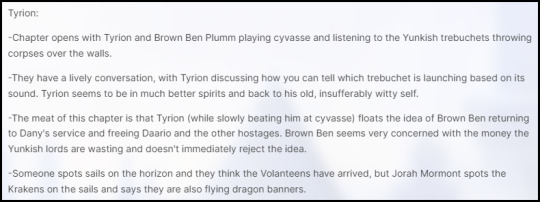

Don't worry, it will be over quickly.
Chapter opens with Tyrion and Brown Ben Plumm playing cyvasse and listening to the Yunkish trebuchets throwing corpses over the walls. They have a lively conversation, with Tyrion discussing how you can tell which trebuchet is launching based on its sound. Tyrion seems to be in much better spirits and back to his old, insufferably witty self.
x
For the second chapter we joined Tyrion playing cyvasse with Brown Ben, while they wait for 'Ser Grandfather's' army to sally forth and try to break the siege of Meereen. These two share banter with other of Brown Ben's staff about what's the worst thing about waiting for the battle to start, punctuated by the sound of the trebuchets as they fling more plague corpses into Meereen.
Oh boy, I can hardly wait to read this. I can already feel the laughter bubbling up inside of me.
+.+.+
Brown Ben muses that the two dragons are wild cards which could attack anyything on either side during the battle.
🚩🚩🚩
Uh oh! UH OH.
That is the second time that prospect has been mentioned, essentially guaranteeing it will happen.
They will come, Ser Barristan might have said. The noise will bring them, the shouts and screams, the scent of blood. That will draw them to the battlefield, just as the roar from Daznak's Pit drew Drogon to the scarlet sands. But when they come, will they know one side from the other? Somehow he did not think so. - The Queen's Hands, ADWD
Can't wait to hear the excuses when the Unsullied and "freedmen" are caught in the crosshairs.
+.+.+
Tyrion (while slowly beating him at cyvasse) floats the idea of Brown Ben returning to Dany’s service and freeing Daario and the other hostages. Brown Ben seems very concerned with the money the Yunkish lords are wasting and doesn’t immediately reject the idea.
x
They assume Dany will return on the third dragon and speculate about rescuing the three hostages - Daario, the eunuch and the horse boy - and delivering them to Meereen thereby changing sides a second time but claiming that they only pretended to change sides before so as to learn the Yunkish plans.
Of course he's winning.
We learn two things:
Daario is still alive. No trebuchet.
Tyrion and Brown Ben are probably going to rescue him.
+.+.+
Tyrion thinks any skepticism about this will be outweighed by gratitude that he killed Dany's most dangerous enemy - Tywin.
How hard will I laugh when Tyrion Lannister talks circles around this girl, and eventually convinces her to accept him as an ally? God, how embarrassing.
Anyway, she seems poised to misidentify the lion from Quaithe's warning, just as we all anticipated.
+.+.+
Someone spots sails on the horizon and they think the Volantenes have arrived, but Jorah Mormont spots the Krakens on the sails and says they are also flying dragon banners.
x
Just as Tyrion is about to win the cyvasse game Jorah bursts in with news of black sails in the bay (ironborn ships) flying dragon banners.
🚩🚩🚩
Everyone stop everything, it's DRAGON BANNERS.
Tyrion I dramatically ends with Victarion's fleet entering the battle, proudly displaying dragon banners atop their masts. It's like he already knows her love language.
Why might this be important?
We must go back!
Glowing like sunset, a red sword was raised in the hand of a blue-eyed king who cast no shadow. A cloth dragon swayed on poles amidst a cheering crowd. From a smoking tower, a great stone beast took wing, breathing shadow fire. . . . mother of dragons, slayer of lies . . - Daenerys IV, ACOK
This vision from the House of the Undying is almost always assigned to Aegon VI Targaryen.
Why?
"A dead man in the prow of a ship, a blue rose, a banquet of blood . . . what does any of it mean, Khaleesi? A mummer's dragon, you said. What is a mummer's dragon, pray?"
"A cloth dragon on poles," Dany explained. "Mummers use them in their follies, to give the heroes something to fight." - Daenerys V, ACOK
Because of Daenerys.
Despite mummers never making an appearance in that chapter or having any connection to the vision, Daenerys concludes that a cloth dragon swaying on poles is referencing stunts performed by mummers.
This becomes even more convoluted when books later Quaithe actually does warn Daenerys about a mummer's dragon.
"No. Hear me, Daenerys Targaryen. The glass candles are burning. Soon comes the pale mare, and after her the others. Kraken and dark flame, lion and griffin, the sun's son and the mummer's dragon. Trust none of them. Remember the Undying. Beware the perfumed seneschal." - Daenerys II, ADWD
As a result, many connect Quaithe's mummer's dragon to the cloth dragon swaying on poles from the House of the Undying. It's all Aegon, everything is Aegon.
I don't want to get too deep into this, because we've already covered Quaithe and the HotU extensively, but I will say I think there's a lot of problems here.
Reaching a conclusion that largely relies on Daenerys' interpretation of any vision is a bad idea.
I believe the "mother of dragons, slayer of lies" group of visions are interconnected through the concept of Azor Ahai being a lie, which has nothing to do with Aegon.
The author consistently portrays engaging in a violent pursuit of the Iron Throne as inherently immoral, and that will have to include Aegon (I'm sorry). It's hard to imagine a scenario where common folk rally to an invading army causing mass devastation, and starvation.
The vision perfectly complements Daenerys' cult of personality, and messianic complex.
Finally, and this is the most crucial thing to note, anyone following the story closely should recognize it's Daenerys who is fixated on the idea of people supporting her cause under the symbol of her dragon banners.
"They are your people, and they love you well," Magister Illyrio said amiably. "In holdfasts all across the realm, men lift secret toasts to your health while women sew dragon banners and hide them against the day of your return from across the water." - Daenerys I, AGOT
x
Dany rode close beside him. "Still," she said, "the common people are waiting for him. Magister Illyrio says they are sewing dragon banners and praying for Viserys to return from across the narrow sea to free them." - Daenerys III, AGOT
x
"When the day comes that you raise your banners, half of Westeros will be with you," Whitebeard promised. "Your brother Rhaegar is still remembered, with great love." - Daenerys II, ASOS
x
"Tell me, then—when he touched a man on the shoulder with his sword, what did he say? 'Go forth and kill the weak'? Or 'Go forth and defend them'? At the Trident, those brave men Viserys spoke of who died beneath our dragon banners—did they give their lives because they believed in Rhaegar's cause, or because they had been bought and paid for?" Dany turned to Mormont, crossed her arms, and waited for an answer. - Daenerys II, ASOS
x
I ought to have a banner sewn, she thought as she led her tattered band up along Astapor's meandering river. She closed her eyes to imagine how it would look: all flowing black silk, and on it the red three-headed dragon of Targaryen, breathing golden flames. A banner such as Rhaegar might have borne. - Daenerys III, ASOS
You are more than welcome to believe that vision is Aegon, there's not a lot of evidence either way, but I'm going to stick with the girl who spends five books fantasizing about dragon banners and the people's adoration.
In conclusion, I don't know if Vic's dragon banners are the cloth dragon banners, but I haven't come across a more convincing alternative.
Final thoughts:
48 down, 1 to go. PRAISE BE.

Next chapter: Barristan II (summary)
-> return to menu <-
86 notes
·
View notes